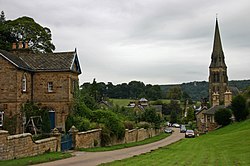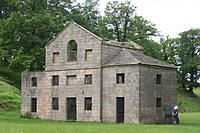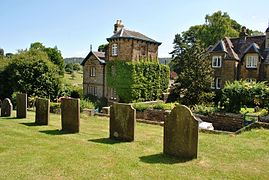Edensor
| Edensor | |
| Derbyshire | |
|---|---|
 Edensor | |
| Location | |
| Grid reference: | SK251700 |
| Location: | 53°13’37"N, 1°37’30"W |
| Data | |
| Population: | 145 (2011) |
| Post town: | Bakewell |
| Postcode: | DE45 |
| Dialling code: | 01629 |
| Local Government | |
| Council: | Derbyshire Dales |
| Parliamentary constituency: |
Derbyshire Dales |
Edensor is a village in Derbyshire. The population of the civil parish as of the 2011 census was 145. It is part of the Chatsworth Estate: the mighty Chatsworth House, one the Seven Wonders of the Peak, stands half a mile to the east of the village: its park wraps around two sides of Edensor.
Much of the village is privately owned, by the Dukes of Devonshire, the Cavendish family. The usual family burial place, holding many of the departed Cavendishes, is in the churchyard of St Peter's Church.
History
A village near this location was included in the Domesday Book of 1086. At that time, it was owned by Henry de Ferrers and included ten villeins plus seven bordars.[1]
One report describes the area in the early 1700s as: "it straggled across towards the river Derwent in front of Chatsworth, skirting the hill opposite the village known as 'The Crobbs'."[2]
In 1762 the 4th Duke of Devonshire of Chatsworth House arranged for the demolition of several buildings because they intruded on his view of the parkland that had been created by Capability Brown. In the 1800s, a new road was being built and the Duke arranged to have the rest of the village removed. A new village was constructed in a project managed by Sir Joseph Paxton; the earlier vicarage and an existing 18th-century inn were moved to the new site. Just one building of the old village, Park Cottage, was not removed.
A church existed here in the 1100s but it was rebuilt and increased in size in the mid 1800s.[3][4][5]
A report published in 1870 stated that the village was "a pretty place of villa-cottages" and had a post office and an inn, as well as 123 houses". The population of the township, including the village, was 592.[6]
In 2019 some 575 people worked on the Chatsworth Estate which included the village.[7] This area has been the home of the Cavendish family since 1549.[8]
By the mid-1800s, Edensor was considered to be a "model village"; "rules were being enforced to preserve the appearance of the settlement".[9]
The Chatsworth Estate office occupies a "fine brick building"[10] which was built as an inn for visitors to Chatsworth in the 18th century and attributed to James Paine. As of 2021, 50 of the buildings in the village are listed buildings, all Grade II (with a few at Grade II*) except for the Church of St Peter was is Grade I Listed.
St Peter's Church
The current church with its 1,66ft-high spire, designed by George Gilbert Scott, was built about 25 years after the village was completed, in 1867, as a replacement for the church that had occupied the site previously, reportedly a squat-towered edifice of Norman origin.[11][12]
Very little remains of the Norman church, though some traces can be found in today's church. The original St Peter's was built in the 12th century and modified in the 15th century before ebeing taken down and replaced in 1867.[13]
Dunsa
A hamlet, Dunsa, stands to the north-west of Edensor.
Pictures
See also
Outside links
| ("Wikimedia Commons" has material about Edensor) |
References
- ↑ Edensor in the Domesday Book
- ↑ St Peter's Church, Edensor
- ↑ "Exploring the idyllic Chatsworth village of Edensor". https://www.greatbritishlife.co.uk/homes-and-gardens/places-to-live/edensor-village-6520772.
- ↑ Edensor: Let's Go Peak District
- ↑ "Edensor, Derbyshire". https://www.britainexpress.com/counties/derbyshire/az/edensor.htm.
- ↑ "Parish History The Imperial Gazetteer of England & Wales 1870". https://www.parishmouse.co.uk/derbyshire/edensor-derbyshire-family-history-guide/.
- ↑ National Heritage List 1373871: Chatsworth House (Grade I listing)
- ↑ Edensor and the Chatsworth Estate: Chatsworth Estate
- ↑ "Exploring the idyllic Chatsworth village of Edensor". https://www.greatbritishlife.co.uk/homes-and-gardens/places-to-live/edensor-village-6520772.
- ↑ Nikolaus Pevsner: The Buildings of England: Derbyshire, 1953; 1978 Penguin Books ISBN 978-0-300-09591-3
- ↑ "Exploring the idyllic Chatsworth village of Edensor". https://www.greatbritishlife.co.uk/homes-and-gardens/places-to-live/edensor-village-6520772.
- ↑ Building record: St Peter's Church, Jap Lane, Edensor
- ↑ National Heritage List 1088158: Church of St Peter (Grade I listing)









